Answered step by step
Verified Expert Solution
Question
1 Approved Answer
In this write up, the following should be covered: What is the primary issue facing the firm? What are the secondary issues facing the firm?
In this write up, the following should be covered:
- What is the primary issue facing the firm?
- What are the secondary issues facing the firm?
- What is the most appropriate action for the firm?
- What resources do they have/can they get to do what you suggest?
- Why should the firm do what you suggest? Why is this a better course of action than alternative options?
- What are the implications of the strategy you suggest? (i.e. how might your competition, customers or suppliers respond to this strategy)
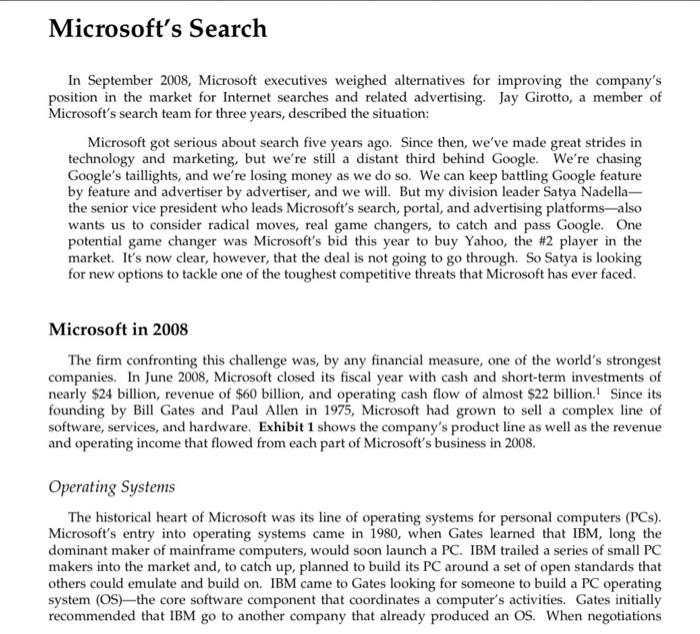
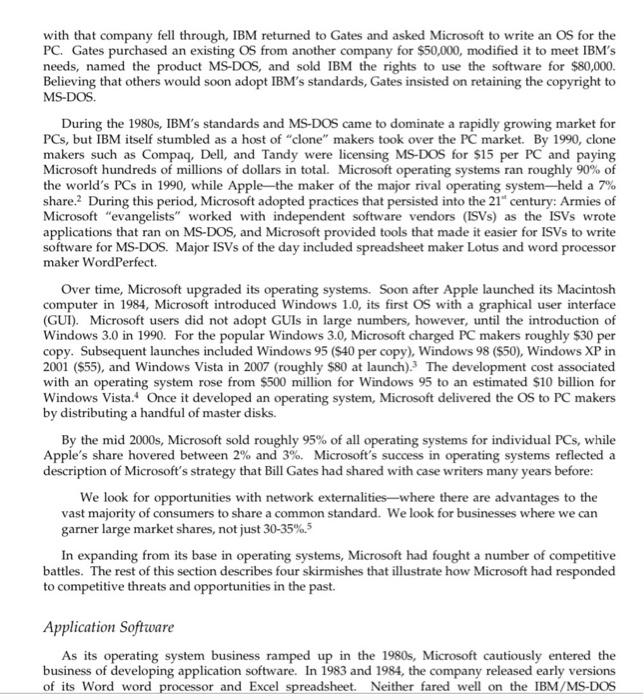

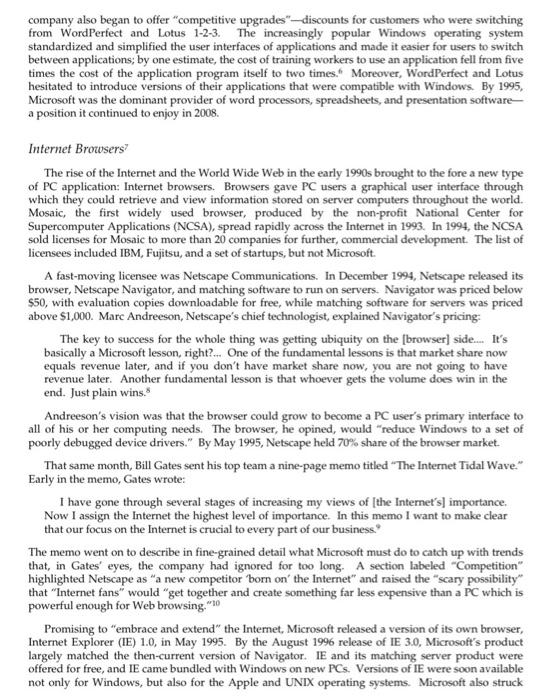


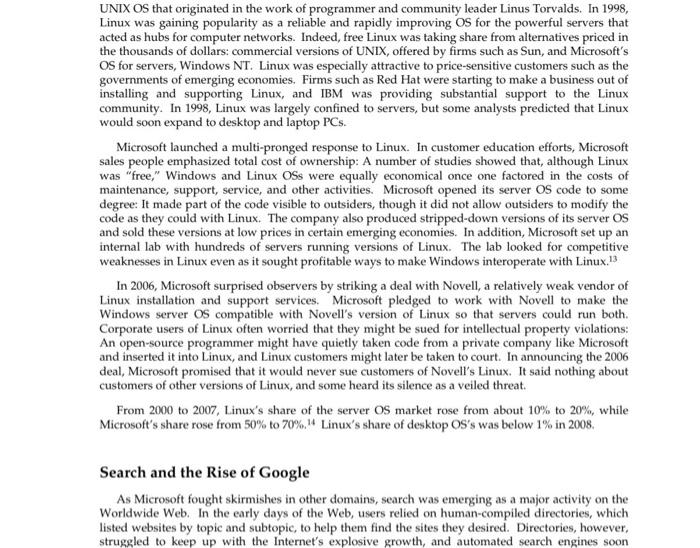
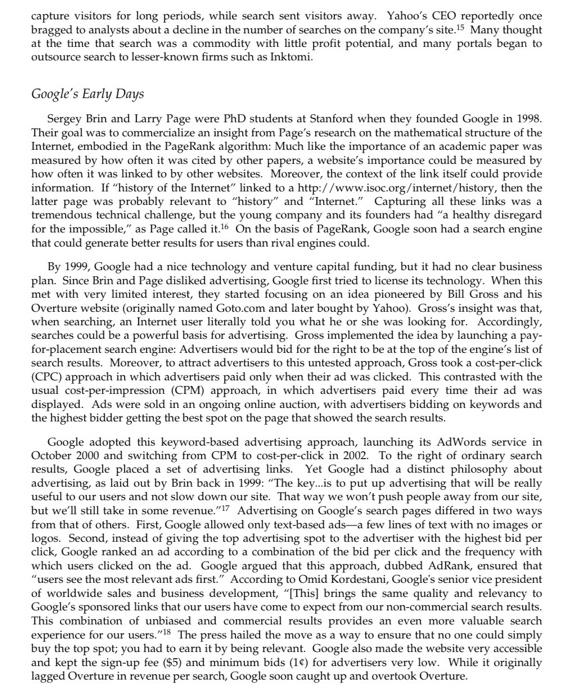

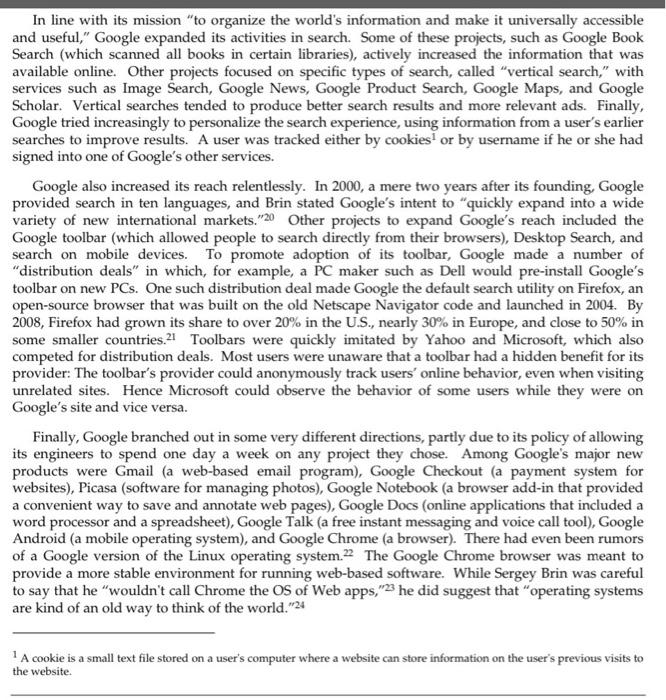
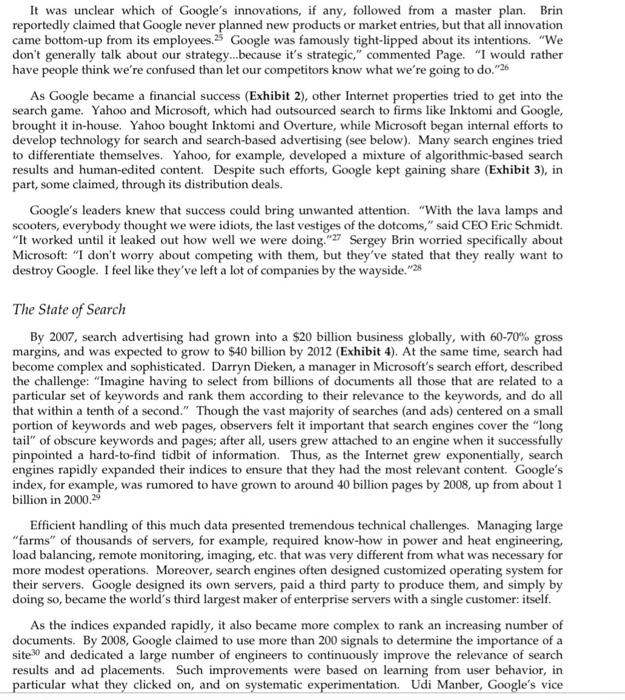

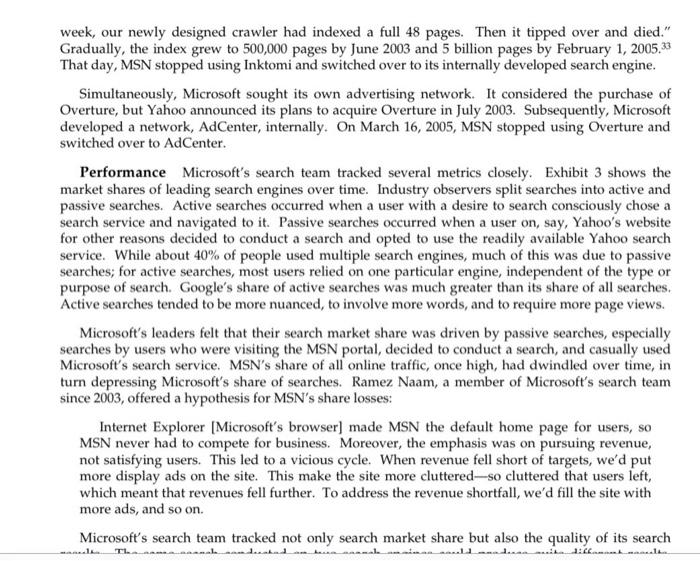
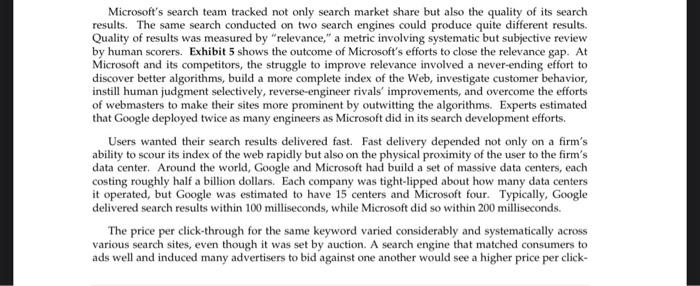

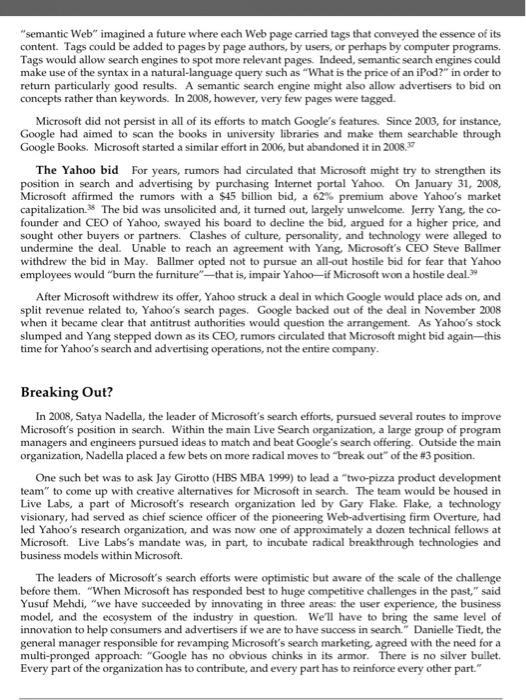
3 pages max please
In September 2008, Microsoft executives weighed alternatives for improving the company's position in the market for Internet searches and related advertising. Jay Girotto, a member of Microsoft's search team for three years, described the situation: Microsoft got serious about search five years ago. Since then, we've made great strides in technology and marketing, but we're still a distant third behind Google. We're chasing Google's taillights, and we're losing money as we do so. We can keep battling Google feature by feature and advertiser by advertiser, and we will. But my division leader Satya Nadellathe senior vice president who leads Microsoft's search, portal, and advertising platforms - also wants us to consider radical moves, real game changers, to catch and pass Google. One potential game changer was Microsoft's bid this year to buy Yahoo, the \#2 player in the market. It's now clear, however, that the deal is not going to go through. So Satya is looking for new options to tackle one of the toughest competitive threats that Microsoft has ever faced. Microsoft in 2008 The firm confronting this challenge was, by any financial measure, one of the world's strongest companies. In June 2008, Microsoft closed its fiscal year with cash and short-term investments of nearly $24 billion, revenue of $60 billion, and operating cash flow of almost $22 billion. 1 Since its founding by Bill Gates and Paul Allen in 1975, Microsoft had grown to sell a complex line of software, services, and hardware. Exhibit 1 shows the company's product line as well as the revenue and operating income that flowed from each part of Microsoft's business in 2008. Operating Systems The historical heart of Microsoft was its line of operating systems for personal computers (PCs). Microsoft's entry into operating systems came in 1980, when Gates learned that IBM, long the dominant maker of mainframe computers, would soon launch a PC. IBM trailed a series of small PC makers into the market and, to catch up, planned to build its PC around a set of open standards that others could emulate and build on. IBM came to Gates looking for someone to build a PC operating system (OS) - the core software component that coordinates a computer's activities. Gates initially recommended that IBM go to another company that already produced an OS. When negotiations with that company fell through, IBM returned to Gates and asked Microsoft to write an OS for the PC. Gates purchased an existing OS from another company for $50,000, modified it to meet IBM's needs, named the product MS-DOS, and sold IBM the rights to use the software for $80,000. Believing that others would soon adopt IBM's standards, Gates insisted on retaining the copyright to MS-DOS. During the 1980s, IBM's standards and MS-DOS came to dominate a rapidly growing market for PCs, but IBM itself stumbled as a host of "clone" makers took over the PC market. By 1990, clone makers such as Compaq, Dell, and Tandy were licensing MS-DOS for $15 per PC and paying Microsoft hundreds of millions of dollars in total. Microsoft operating systems ran roughly 90% of the world's PCs in 1990, while Apple-the maker of the major rival operating system-held a 7% share. 2 During this period, Microsoft adopted practices that persisted into the 21" century: Armies of Microsoft "evangelists" worked with independent software vendors (ISVs) as the ISVs wrote applications that ran on MS-DOS, and Microsoft provided tools that made it easier for ISVs to write software for MS-DOS. Major ISVs of the day included spreadsheet maker Lotus and word processor maker WordPerfect. Over time, Microsoft upgraded its operating systems. Soon after Apple launched its Macintosh computer in 1984, Microsoft introduced Windows 1.0, its first OS with a graphical user interface (GUI). Microsoft users did not adopt GUIs in large numbers, however, until the introduction of Windows 3.0 in 1990. For the popular Windows 3.0, Microsoft charged PC makers roughly $30 per copy. Subsequent launches included Windows 95 ( $40 per copy), Windows 98 ( $50), Windows XP in 2001 (\$55), and Windows Vista in 2007 (roughly $80 at launch). 3 The development cost associated with an operating system rose from $500 million for Windows 95 to an estimated $10 billion for Windows Vista. 4 Once it developed an operating system, Microsoft delivered the OS to PC makers by distributing a handful of master disks. By the mid 2000 s, Microsoft sold roughly 95% of all operating systems for individual PCs, while Apple's share hovered between 2% and 3%. Microsoft's success in operating systems reflected a description of Microsoft's strategy that Bill Gates had shared with case writers many years before: We look for opportunities with network externalities-where there are advantages to the vast majority of consumers to share a common standard. We look for businesses where we can garner large market shares, not just 3035%5 In expanding from its base in operating systems, Microsoft had fought a number of competitive battles. The rest of this section describes four skirmishes that illustrate how Microsoft had responded to competitive threats and opportunities in the past. Application Software As its operating system business ramped up in the 1980s, Microsoft cautiously entered the business of developing application software. In 1983 and 1984, the company released early versions Application Software As its operating system business ramped up in the 1980 s, Microsoft cautiously entered the business of developing application software. In 1983 and 1984, the company released early versions of its Word word processor and Excel spreadsheet. Neither fared well on the IBM/MS-DOS standard, where WordPerfect and Lotus 1-2-3 were dominant. However, Word and Excel soon became leading applications on the Apple standard, where WordPerfect and Lotus made less effort. Microsoft allegedly used its Apple-based development of Word and Excel to learn about graphical user interfaces and to enhance the GUI of its Windows operating system. Around 1990, Microsoft became more aggressive in application software for IBM-standard PCs. Microsoft began to bundle Word, Excel, and PowerPoint into a popular suite, Microsoft Office. The company also began to offer "competitive upgrades"-discounts for customers who were switching from WordPerfect and Lotus 1-2-3. The increasingly popular Windows operating system standardized and simplified the user interfaces of applications and made it easier for users to switch between applications; by one estimate, the cost of training workers to use an application fell from five times the cost of the application program itself to two times. 6 Moreover, WordPerfect and Lotus hesitated to introduce versions of their applications that were compatible with Windows. By 1995 , Microsoft was the dominant provider of word processors, spreadsheets, and presentation softwarea position it continued to enjoy in 2008 . Internet Browsers 7 The rise of the Internet and the World Wide Web in the early 1990s brought to the fore a new type of PC application: Internet browsers. Browsers gave PC users a graphical user interface through which they could retrieve and view information stored on server computers throughout the world. Mosaic, the first widely used browser, produced by the non-profit National Center for Supercomputer Applications (NCSA), spread rapidly across the Internet in 1993. In 1994, the NCSA sold licenses for Mosaic to more than 20 companies for further, commercial development. The list of licensees included IBM, Fujitsu, and a set of startups, but not Microsoft. A fast-moving licensee was Netscape Communications. In December 1994, Netscape released its browser, Netscape Navigator, and matching software to run on servers. Navigator was priced below $50, with evaluation copies downloadable for free, while matching software for servers was priced above \$1,000. Marc Andreeson, Netscape's chief technologist, explained Navigator's pricing: The key to success for the whole thing was getting ubiquity on the [browser] side... It's basically a Microsoft lesson, right?... One of the fundamental lessons is that market share now equals revenue later, and if you don't have market share now, you are not going to have revenue later. Another fundamental lesson is that whoever gets the volume does win in the end. Just plain wins. 5 Andreeson's vision was that the browser could grow to become a PC user's primary interface to all of his or her computing needs. The browser, he opined, would "reduce Windows to a set of poorly debugged device drivers." By May 1995, Netscape held 70% share of the browser market. That same month, Bill Gates sent his top team a nine-page memo titled "The Internet Tidal Wave." Early in the memo, Gates wrote: I have gone through several stages of increasing my views of [the Internet's] importance. Now I assign the Internet the highest level of importance. In this memo I want to make clear that our focus on the Internet is crucial to every part of our business. The memo went on to describe in fine-grained detail what Microsoft must do to catch up with trends that, in Gates' eyes, the company had ignored for too long. A section labeled "Competition" highlighted Netscape as "a new competitor born on' the Internet" and raised the "scary possibility" that "Internet fans" would "get together and create something far less expensive than a PC which is powerful enough for Web browsing." "10 Promising to "embrace and extend" the Internet, Microsoft released a version of its own browser, Internet Explorer (IE) 1.0, in May 1995. By the August 1996 release of IE 3.0, Microsoft's product largely matched the then-current version of Navigator. IE and its matching server product were offered for free, and IE came bundled with Windows on new PCs. Versions of IE were soon available not only for Windows, but also for the Apple and UNIX operating systems. Microsoft also struck deals with Internet service providers (ISPs), who agreed to install IE as they provided Internet access to consumers. To convince America Online, the largest ISP, to promote IE, Microsoft agreed to place AOL's icon on the Windows desktop, even though AOL competed with Microsoft's own ISP offering. Netscape tried to survive by quickening its pace of innovation, by opening its source code so that others could improve its products, and by diversifying into new products. However, Netscape's development costs rose rapidly, its browser share plunged, and webmasters increasingly optimized Netscape tried to survive by quickening its pace of innovation, by opening its source code so that others could improve its products, and by diversifying into new products. However, Netscape's development costs rose rapidly, its browser share plunged, and webmasters increasingly optimized their Web sites for IE, not Navigator. In November 1998, Netscape collapsed into the arms of AOL, selling out for $4.3 billion in stock. By late 2002, Microsoft's browser market share surpassed 95%. Microsoft's conduct in the browser market prompted the U.S. Department of Justice to bring an antitrust case against the company in 1998. Prosecutors argued that, by bundling IE with Windows, Microsoft had abused the power of its operating system monopoly in order to create a new monopoly in the browser market; "embrace and extend" had allegedly become "embrace, extend, and extinguish." An initial finding against Microsoft called for the company to be broken in two, with the operating system part of Microsoft split from the rest of the organization. An appeal was successful, however, and in 2001 Microsoft reached a settlement with the government. The settlement required Microsoft to disclose certain aspects of its software code to other firms and prohibited discriminatory agreements with PC makers. It also barred Microsoft from bundling other applications with Windows in the future unless rival makers of such applications had equal access to being bundled with Windows. The settlement did not formally prohibit the bundling of other Microsoft products, but the experience made Microsoft's leaders skittish about bundling. Java As the Internet rose to prominence, so did Java, a programming language championed by Sun Microsystems. Using Java, programmers could write small applications, known as "applets," that users might reach via a Web browser. Java appealed to programmers in part because it promised the ability to "write once, run anywhere": An applet would run the same on any computer, regardless of its operating system, thanks to "middleware" that sat between the applet and the operating system. Microsoft licensed Java from Sun in 1995. It then developed and promoted a version of Java that ran best with Windows-i.e., would not operate equally well "cross-platform." Sun sued Microsoft in 1997 for creating a "polluted" version of Java and again in 2002 for making Windows XP incompatible with Java. Indeed, government attorneys discovered an email in which a Microsoft employee advocated "stealing" and "killing" Java." A settlement in 2004, which included a $1.6 billion payment from Microsoft to Sun, seemed to resolve the companies' dispute. 12 By then, Java was playing a smaller role in programming circles than many had expected in its early days. The Sun settlement, the browser antitrust case, and a host of other legal battles made Microsoft's leaders increasingly careful about their competitive actions. By 2008, employees felt that the company, though aggressive, was highly conscious of the legal constraints that accompanied its leading position. Linx In 1998, even as the browser and Java battles raged, memos circulating within Microsoft's top ranks warned of a new threat: open-source software and especially the Linux operating system. Open-source software was developed not by a company, but by an online community of programmers who contributed and improved code for free. Linux was an open-source version of the UNIX OS that originated in the work of programmer and community leader Linus Torvalds. In 1998, Linux was gaining popularity as a reliable and rapidly improving OS for the powerful servers that acted as hubs for computer networks. Indeed, free Linux was taking share from alternatives priced in the thousands of dollars: commercial versions of UNIX, offered by firms such as Sun, and Microsoft's OS for servers, Windows NT. Linux was especially attractive to price-sensitive customers such as the governments of emerging economies. Firms such as Red Hat were starting to make a business out of installing and supporting Linux, and IBM was providing substantial support to the Linux community. In 1998, Linux was largely confined to servers, but some analysts predicted that Linux would soon expand to desktop and laptop PCs. Microsoft launched a multi-pronged response to Linux. In customer education efforts, Microsoft sales people emphasized total cost of ownership: A number of studies showed that, although Linux was "free," Windows and Linux OSs were equally economical once one factored in the costs of maintenance, support, service, and other activities. Microsoft opened its server OS code to some degree: It made part of the code visible to outsiders, though it did not allow outsiders to modify the code as they could with Linux. The company also produced stripped-down versions of its server OS and sold these versions at low prices in certain emerging economies. In addition, Microsoft set up an internal lab with hundreds of servers running versions of Linux. The lab looked for competitive weaknesses in Linux even as it sought profitable ways to make Windows interoperate with Linux. 13 In 2006, Microsoft surprised observers by striking a deal with Novell, a relatively weak vendor of Linux installation and support services. Microsoft pledged to work with Novell to make the Windows server OS compatible with Novell's version of Linux so that servers could run both. Corporate users of Linux often worried that they might be sued for intellectual property violations: An open-source programmer might have quietly taken code from a private company like Microsoft and inserted it into Linux, and Linux customers might later be taken to court. In announcing the 2006 deal, Microsoft promised that it would never sue customers of Novell's Linux. It said nothing about customers of other versions of Linux, and some heard its silence as a veiled threat. From 2000 to 2007, Linux's share of the server OS market rose from about 10% to 20%, while Microsoft's share rose from 50% to 70%,14 Linux's share of desktop OS's was below 1% in 2008. Search and the Rise of Google As Microsoft fought skirmishes in other domains, search was emerging as a major activity on the Worldwide Web. In the early days of the Web, users relied on human-compiled directories, which listed websites by topic and subtopic, to help them find the sites they desired. Directories, however. struggled to keep up with the Internet's explosive growth, and automated search engines soon capture visitors for long periods, while search sent visitors away. Yahoo's CEO reportedly once bragged to analysts about a decline in the number of searches on the company's site. 15 Many thought at the time that search was a commodity with little profit potential, and many portals began to outsource search to lesser-known firms such as Inktomi. Google's Early Days Sergey Brin and Larry Page were PhD students at Stanford when they founded Google in 1998. Their goal was to commercialize an insight from Page's research on the mathematical structure of the Internet, embodied in the PageRank algorithm: Much like the importance of an academic paper was measured by how often it was cited by other papers, a website's importance could be measured by how often it was linked to by other websites. Moreover, the context of the link itself could provide information. If "history of the Internet" linked to a http://www.isoc.org/internet/history, then the latter page was probably relevant to "history" and "Internet." Capturing all these links was a tremendous technical challenge, but the young company and its founders had "a healthy disregard for the impossible," as Page called it. .16 On the basis of PageRank, Google soon had a search engine that could generate better results for users than rival engines could. By 1999, Google had a nice technology and venture capital funding, but it had no clear business plan. Since Brin and Page disliked advertising, Google first tried to license its technology. When this met with very limited interest, they started focusing on an idea pioneered by Bill Gross and his Overture website (originally named Goto.com and later bought by Yahoo). Gross's insight was that, when searching, an Internet user literally told you what he or she was looking for. Accordingly, searches could be a powerful basis for advertising. Gross implemented the idea by launching a payfor-placement search engine: Advertisers would bid for the right to be at the top of the engine's list of search results. Moreover, to attract advertisers to this untested approach, Gross took a cost-per-click (CPC) approach in which advertisers paid only when their ad was clicked. This contrasted with the usual cost-per-impression (CPM) approach, in which advertisers paid every time their ad was displayed. Ads were sold in an ongoing online auction, with advertisers bidding on keywords and the highest bidder getting the best spot on the page that showed the search results. Google adopted this keyword-based advertising approach, launching its AdWords service in October 2000 and switching from CPM to cost-per-click in 2002. To the right of ordinary search results, Google placed a set of advertising links. Yet Google had a distinct philosophy about advertising, as laid out by Brin back in 1999: "The key...is to put up advertising that will be really useful to our users and not slow down our site. That way we won't push people away from our site, but we'll still take in some revenue."17 Advertising on Google's search pages differed in two ways from that of others. First, Google allowed only text-based ads-a few lines of text with no images or logos. Second, instead of giving the top advertising spot to the advertiser with the highest bid per click, Google ranked an ad according to a combination of the bid per click and the frequency with which users clicked on the ad. Google argued that this approach, dubbed AdRank, ensured that "users see the most relevant ads first." According to Omid Kordestani, Google's senior vice president of worldwide sales and business development, "[This] brings the same quality and relevancy to Google's sponsored links that our users have come to expect from our non-commercial search results. This combination of unbiased and commercial results provides an even more valuable search experience for our users. 18 The press hailed the move as a way to ensure that no one could simply buy the top spot; you had to earn it by being relevant. Google also made the website very accessible and kept the sign-up fee ( $5) and minimum bids (1e) for advertisers very low. While it originally lagged Overture in revenue per search, Google soon caught up and overtook Overture. In 2003, Google introduced AdSense: Any website publisher could let Google place ads on its pages in exchange for a share in the revenue. In particular, Google would scan the publisher's pages to identify keywords, select relevant ads, and place the ads on the pages. Sometimes Google would also run the site's search utility and then place ads, just as with its own search. By providing an easy source of income to even the smallest of websites, the program could "spur the next generation of content development," Brin felt. 19 The program also dramatically expanded Google's reach and revenue (Exhibit 2). Some advertisers, however, complained that users who arrived at their sites via AdSense ads were not very good sales leads for their sites. In response to such complaints, Google allowed advertisers to opt not to have their ads appear on such Google Network sites. In line with its mission "to organize the world's information and make it universally accessible and useful, "Google expanded its activities in search. Some of these projects, such as Google Book In line with its mission "to organize the world's information and make it universally accessible and useful," Google expanded its activities in search. Some of these projects, such as Google Book Search (which scanned all books in certain libraries), actively increased the information that was available online. Other projects focused on specific types of search, called "vertical search," with services such as Image Search, Google News, Google Product Search, Google Maps, and Google Scholar. Vertical searches tended to produce better search results and more relevant ads. Finally, Google tried increasingly to personalize the search experience, using information from a user's earlier searches to improve results. A user was tracked either by cookies 1 or by username if he or she had signed into one of Google's other services. Google also increased its reach relentlessly. In 2000, a mere two years after its founding, Google provided search in ten languages, and Brin stated Google's intent to "quickly expand into a wide variety of new international markets." 20 Other projects to expand Google's reach included the Google toolbar (which allowed people to search directly from their browsers), Desktop Search, and search on mobile devices. To promote adoption of its toolbar, Google made a number of "distribution deals" in which, for example, a PC maker such as Dell would pre-install Google's toolbar on new PCs. One such distribution deal made Google the default search utility on Firefox, an open-source browser that was built on the old Netscape Navigator code and launched in 2004. By 2008 , Firefox had grown its share to over 20% in the U.S., nearly 30% in Europe, and close to 50% in some smaller countries. 21 Toolbars were quickly imitated by Yahoo and Microsoft, which also competed for distribution deals. Most users were unaware that a toolbar had a hidden benefit for its provider: The toolbar's provider could anonymously track users' online behavior, even when visiting unrelated sites. Hence Microsoft could observe the behavior of some users while they were on Google's site and vice versa. Finally, Google branched out in some very different directions, partly due to its policy of allowing its engineers to spend one day a week on any project they chose. Among Google's major new products were Gmail (a web-based email program), Google Checkout (a payment system for websites), Picasa (software for managing photos), Google Notebook (a browser add-in that provided a convenient way to save and annotate web pages), Google Docs (online applications that included a word processor and a spreadsheet), Google Talk (a free instant messaging and voice call tool), Google Android (a mobile operating system), and Google Chrome (a browser). There had even been rumors of a Google version of the Linux operating system. 22 The Google Chrome browser was meant to provide a more stable environment for running web-based software. While Sergey Brin was careful to say that he "wouldn't call Chrome the OS of Web apps," 23 he did suggest that "operating systems are kind of an old way to think of the world."24 1 A cookie is a small text file stored on a user's computer where a website can store information on the user's previous visits to the website. It was unclear which of Google's innovations, if any, followed from a master plan. Brin reportedly claimed that Google never planned new products or market entries, but that all innovation came bottom-up from its employees. 25 Google was famously tight-lipped about its intentions. "We don't generally talk about our strategy...because it's strategic," commented Page. "I would rather have people think we're confused than let our competitors know what we're going to do."26 As Google became a financial success (Exhibit 2), other Internet properties tried to get into the search game. Yahoo and Microsoft, which had outsourced search to firms like Inktomi and Google, brought it in-house. Yahoo bought Inktomi and Overture, while Microsoft began internal efforts to develop technology for search and search-based advertising (see below). Many search engines tried to differentiate themselves. Yahoo, for example, developed a mixture of algorithmic-based search results and human-edited content. Despite such efforts, Google kept gaining share (Exhibit 3), in part, some claimed, through its distribution deals. Google's leaders knew that success could bring unwanted attention. "With the lava lamps and scooters, everybody thought we were idiots, the last vestiges of the dotcoms," said CEO Eric Schmidt. "It worked until it leaked out how well we were doing." .27 Sergey Brin worried specifically about Microsoft: "I don't worry about competing with them, but they've stated that they really want to destroy Google. I feel like they've left a lot of companies by the wayside."28 The State of Search By 2007, search advertising had grown into a $20 billion business globally, with 6070% gross margins, and was expected to grow to $40 billion by 2012 (Exhibit 4). At the same time, search had become complex and sophisticated. Darryn Dieken, a manager in Microsoft's search effort, described the challenge: "Imagine having to select from billions of documents all those that are related to a particular set of keywords and rank them according to their relevance to the keywords, and do all that within a tenth of a second." Though the vast majority of searches (and ads) centered on a small portion of keywords and web pages, observers felt it important that search engines cover the "long tail" of obscure keywords and pages; after all, users grew attached to an engine when it successfully pinpointed a hard-to-find tidbit of information. Thus, as the Internet grew exponentially, search engines rapidly expanded their indices to ensure that they had the most relevant content. Google's index, for example, was rumored to have grown to around 40 billion pages by 2008 , up from about 1 billion in 2000.29 Efficient handling of this much data presented tremendous technical challenges. Managing large "farms" of thousands of servers, for example, required know-how in power and heat engineering, load balancing, remote monitoring, imaging, etc. that was very different from what was necessary for more modest operations. Moreover, search engines often designed customized operating system for their servers. Google designed its own servers, paid a third party to produce them, and simply by doing so, became the world's third largest maker of enterprise servers with a single customer: itself. As the indices expanded rapidly, it also became more complex to rank an increasing number of documents. By 2008, Google claimed to use more than 200 signals to determine the importance of a site 30 and dedicated a large number of engineers to continuously improve the relevance of search results and ad placements. Such improvements were based on learning from user behavior, in particular what they clicked on, and on systematic experimentation. Udi Manber, Google's vice The same complexity and continuous improvement applied to the AdRank software. By 2008 , AdRank took into account not only the historical click-through rate of an ad, but also the relevance of the keyword to the ad, the loading time of the landing page, the performance of the advertiser's account in the geographical region, and many other factors that were not publicly revealed. Some observers suspected that the ranking of search results and the placement of ads was not completely independent. In particular, retailers would typically show up at the bottom of the ranking when a user searched for a product. One retailer whose site had dropped hundreds of spots overnight complained, "I had to buy AdWords. They forced me to do it." The process of bidding on keywords was simple but often very time-consuming for advertisers. Some advertisers retained entire groups of employees to bid on thousands of keywords continuously. To alleviate associated costs, search companies helped advertisers manage the process of planning, executing, and evaluating online advertising. Google Analytics, for example, helped advertisers track traffic on their site to identify the effectiveness of different keywords, while a large staff at Google provided personal assistance to current and potential advertisers. Interest in search and search-related advertising increased in the late 2000 s as some observers predicted that the software industry would move to "software as a service" and "cloud computing." Under this model, PCs would increasingly become devices to reach software, files, and processing power that resided on central servers-in the "cloud" of the network. Instead of buying software for their PCs, users would subscribe to centrally-maintained software or would "pay" for access to software services by viewing ads. It was unclear whether such a future would unfold and, if so, what role search and advertising would play in it. Observers noted that the idea of cloud computing had circulated before - in the mid-1990s, when Sun's motto was, "The network is the computer." Despite all this sophistication and complexity, Yusuf Mehdi, a senior vice president at Microsoft, believed that search was "still in its early days. Users tell us that half of their search queries go unanswered. The average time required to complete a complex query is 3050 minutes. We see users coming back to similar search terms day after day, in part because they haven't found what they wanted. Someday we'll look back and today's search experience will seem downright primitive." Microsoft in Search Development Microsoft first became a search provider as a consequence of other business ventures. Soon after Gates' "Internet tidal wave" memo, Microsoft developed online content such as Slate magazine, migrated its Encarta encyclopedia from CDs to an online site, and launched the Microsoft Network (MSN) -initially, a dial-up Internet access service. Like America Online, MSN was at first a "walled garden" of online services open only to members. As comparies such as Yahoo and Excite became open multi-service portals in 1997-98, MSN was re-launched as an online service open to all. Like other portals, MSN offered search services. Behind the scenes, however, these services were provided by other firms: Inktomi powered MSN's search engine, and Overture served up advertisements. Through fiscal year 2003, MSN generated no profit. In spring of 2003, Google's success in search led Microsoft's top managers to give Christopher Payne and Ken Moss, MSN veterans, a mandate: Build search capabilities within Microsoft. Payne, Moss, and their team considered a purchase of Inktomi or another existing search engine-including, according to rumors, Google. Ultimately, however, the team decided to build a search engine from scratch. Few Microsoft developers were familiar with the algorithmic challenges involved in scouring the Web, constructing an index, and serving up search results from a massive array of servers, and it proved difficult to hire experts from outside. As Yusuf Mehdi recounted, "After a week, our newly designed crawler had indexed a full 48 pages. Then it tipped over and died." Gradually, the index grew to 500,000 pages by June 2003 and 5 billion pages by February 1,200533 That day, MSN stopped using Inktomi and switched over to its internally developed search engine. Simultaneously, Microsoft sought its own advertising network. It considered the purchase of Overture, but Yahoo announced its plans to acquire Overture in July 2003. Subsequently, Microsoft developed a network, AdCenter, internally. On March 16, 2005, MSN stopped using Overture and switched over to AdCenter. Performance Microsoft's search team tracked several metrics closely. Exhibit 3 shows the market shares of leading search engines over time. Industry observers split searches into active and passive searches. Active searches occurred when a user with a desire to search consciously chose a search service and navigated to it. Passive searches occurred when a user on, say, Yahoo's website for other reasons decided to conduct a search and opted to use the readily available Yahoo search service. While about 40% of people used multiple search engines, much of this was due to passive searches; for active searches, most users relied on one particular engine, independent of the type or purpose of search. Google's share of active searches was much greater than its share of all searches. Active searches tended to be more nuanced, to involve more words, and to require more page views. Microsoft's leaders felt that their search market share was driven by passive searches, especially searches by users who were visiting the MSN portal, decided to conduct a search, and casually used Microsoft's search service. MSN's share of all online traffic, once high, had dwindled over time, in turn depressing Microsoft's share of searches. Ramez Naam, a member of Microsoft's search team since 2003, offered a hypothesis for MSN's share losses: Internet Explorer [Microsoft's browser] made MSN the default home page for users, so MSN never had to compete for business. Moreover, the emphasis was on pursuing revenue, not satisfying users. This led to a vicious cycle. When revenue fell short of targets, we'd put more display ads on the site. This make the site more cluttered-so cluttered that users left, which meant that revenues fell further. To address the revenue shortfall, we'd fill the site with more ads, and so on. Microsoft's search team tracked not only search market share but also the quality of its search Microsoft's search team tracked not only search market share but also the quality of its search results. The same search conducted on two search engines could produce quite different results. Quality of results was measured by "relevance," a metric involving systematic but subjective review by human scorers. Exhibit 5 shows the outcome of Microsoft's efforts to close the relevance gap. At Microsoft and its competitors, the struggle to improve relevance involved a never-ending effort to discover better algorithms, build a more complete index of the Web, investigate customer behavior, instill human judgment selectively, reverse-engineer rivals' improvements, and overcome the efforts of webmasters to make their sites more prominent by outwitting the algorithms. Experts estimated that Google deployed twice as many engineers as Microsoft did in its search development efforts. Users wanted their search results delivered fast. Fast delivery depended not only on a firm's ability to scour its index of the web rapidly but also on the physical proximity of the user to the firm's data center. Around the world, Google and Microsoft had build a set of massive data centers, each costing roughly half a billion dollars. Each company was tight-lipped about how many data centers it operated, but Google was estimated to have 15 centers and Microsoft four. Typically, Google delivered search results within 100 milliseconds, while Microsoft did so within 200 milliseconds. The price per click-through for the same keyword varied considerably and systematically across various search sites, even though it was set by auction. A search engine that matched consumers to ads well and induced many advertisers to bid against one another would see a higher price per click- through. In addition, the revenue per search that a site realized depended on the firm's ability to attract enough advertisers - so that it could fill as many advertising slots as possible with relevant ads-and on its ability to target the right ads to the right users. Microsoft managers estimated that their price per click-through was comparable to Yahoo's and roughly 80% of Google's (Exhibit 6). The search companies also differed in the reach of their advertising networks. In 2008, Google catered to roughly 400,000 advertisers, while Yahoo and Microsoft served approximately 175,000 and 60,000 advertisers, respectively. 34 Features Over time, the leading search engines introduced new features to their sites. By 2008 , for instance, most of the leading search engines offered corrections when users misspelled queries; suggested refinements to common searches; searched images as well as text; and suggested complete query terms as users started to type in the search box. A company that introduced a new feature could expect rivals to match it, at least in a rudimentary way, within a couple of months. Since the 2005 launch of its internal search service, Microsoft had tried to distinguish its service in several ways. For instance, the service was integrated with Microsoft's Encarta encyclopedia: When a user submitted a query with a concrete answer (e.g. "population of Spain in 1970"), the service's first response would be a specific answer (e.g., 33,876,479). Microsoft had also committed to a machinelearning approach to improving search relevance, in order to differentiate its results. In 2006, the service's brand switched from MSN Search to Live Search, with the URL http://www.live.com. The "Live" label matched a set of other ad- or subscription-supported online services that Microsoft was then introducing, including Windows Live and Office Live. To stimulate use of its search engine, Microsoft launched in April 2007 a "Live Search Club" where users could win prizes in online games, with "hints" in the form of searches. Its effect was temporary, but industry observers estimated that at the height of its success, the Club generated nearly a third of Microsoft's search volume. For advertisers, Live Search offered the ability to target by user demographics, not just a user's search query. In other ways, Live Search was less permissive toward advertisers. For instance, Microsoft was less willing than Google to let companies bid on search terms that were trademarks of other companies (e.g., allowing Barnes and Noble to bid on the term "Amazon.") Microsoft had made a special effort to make its site unusually effective for product searches. For example, through advanced text and context analysis of online product reviews, Microsoft was able to extract the reviews' sentiment on specific product criteria and summarize these in an "opinion index that was shown when a user searched for a specific product. This feature was replicated by Google within a few months. In May 2008, Live Search launched its most aggressive effort yet to distinguish itself with respect to product searches: the "cashback" program. Under cashback, ads of partner advertisers were marked by a special symbol on each Live Search product results page. If a user clicked through and purchased an item, Microsoft would deposit a rebate of up to 15% of the purchase value into an account set up by the user. In addition, cashback advertisers would often pay Microsoft not when a consumer clicked on an ad but when a consumer purchased a product. At launch, cashback boasted 700 partner advertisers, including Barnes \& Noble.com, Sears, and eBay. 35 Industry experts noted that about a third of all searches were related to product or service purchases. Because ads on those searches commanded especially high prices, they accounted for 80% of all search-related ad revenue. By one estimate, 68% of all online purchases started at a search engine or shopping comparison site. Microsoft also sought to build or buy new search technologies. In August 2008, for instance, it purchased Powerset, a startup, for $100 million. Powerset specialized in semantic search, a technology that many thought would be an important new Web development. Visionaries of the "semantic Web" imagined a future where each Web page carried tags that conveyed the essence of its content. Tags could be added to pages by page authors, by users, or perhaps by computer programs. Tags would allow search engines to spot more relevant pages. Indeed, semantic search engines could make use of the syntax in a natural-language query such as "What is the price of an iPod?" in order to return particularly good results. A semantic search engine might also allow advertisers to bid on concepts rather than keywords. In 2008, however, very few pages were tagged. Microsoft did not persist in all of its efforts to match Google's features. Since 2003, for instance, Google had aimed to scan the books in university libraries and make them searchable through Google Books. Microsoft started a similar effort in 2006, but abandoned it in 2008837 The Yahoo bid For years, rumors had circulated that Microsoft might try to strengthen its position in search and advertising by purchasing Internet portal Yahoo. On January 31, 2008, Microsoft affirmed the rumors with a $45 billion bid, a 62% premium above Yahoo's market capitalization.35 The bid was unsolicited and, it turned out, largely unwelcome. Jerry Yang, the cofounder and CEO of Yahoo, swayed his board to decline the bid, argued for a higher price, and sought other buyers or partners. Clashes of culture, personality, and technology were alleged to undermine the deal. Unable to reach an agreement with Yang, Microsoft's CEO Steve Ballmer withdrew the bid in May. Ballmer opted not to pursue an all-out hostile bid for fear that Yahoo employees would "burn the furniture" - that is, impair Yahoo-if Microsoft won a hostile deal. 34 After Microsoft withdrew its offer, Yahoo struck a deal in which Google would place ads on, and split revenue related to, Yahoo's search pages. Google backed out of the deal in November 2008 when it became clear that antitrust authorities would question the arrangement. As Yahoo's stock slumped and Yang stepped down as its CEO, rumors circulated that Microsoft might bid again-this time for Yahoo's search and advertising operations, not the entire company. Breaking Out? In 2008, Satya Nadella, the leader of Microsoft's search efforts, pursued several routes to improve Microsoft's position in search. Within the main Live Search organization, a large group of program managers and engineers pursued ideas to match and beat Google's search offering. Outside the main organization, Nadella placed a few bets on more radical moves to "break out" of the "3 position. One such bet was to ask Jay Girotto (HBS MBA 1999) to lead a "two-pizza product development team" to come up with creative alternatives for Microsoft in search. The team would be housed in Live Labs, a part of Microsoft's research organization led by Gary Flake. Flake, a technology visionary, had served as chief science officer of the pioneering Web-advertising firm Overture, had led Yahoo's research organization, and was now one of approximately a dozen technical fellows at Microsoft. Live Labs's mandate was, in part, to incubate radical breakthrough technologies and business models within Microsoft. The leaders of Microsoft's search efforts were optimistic but aware of the scale of the challenge before them. "When Microsoft has responded best to huge competitive challenges in the past," said Yusuf Mehdi, "we have succeeded by innovating in three areas: the user experience, the business model, and the ecosystem of the industry in question. We'Il have to bring the same level of innovation to help consumers and advertisers if we are to have success in search." Danielle Tiedt, the general manager responsible for revamping Microsoft's search marketing, agreed with the need for a multi-pronged approach: "Google has no obvious chinks in its armor. There is no silver bullet. Every part of the organization has to contribute, and every part has to reinforce every other part Step by Step Solution
There are 3 Steps involved in it
Step: 1

Get Instant Access to Expert-Tailored Solutions
See step-by-step solutions with expert insights and AI powered tools for academic success
Step: 2

Step: 3

Ace Your Homework with AI
Get the answers you need in no time with our AI-driven, step-by-step assistance
Get Started


